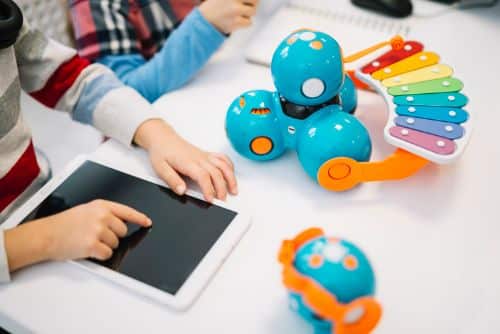Key Highlights
- AAC devices play a role, in aiding individuals with autism spectrum disorder (ASD) who face difficulties with communication.
- These tools can enhance communication abilities, social engagement and language progression for those with ASD.
- Various types of AAC devices are accessible ranging from options like picture exchange communication systems to solutions such as speech generating devices and tablets.
- The advantages of AAC devices are diverse including promoting independence, refining motor skills and addressing communication barriers effectively.
- Choosing the AAC device requires an evaluation of individual needs and capabilities along, with considering the users surroundings and daily routines.
Success Stories
“Move Up ABA has been a lifeline for our family. Before starting therapy, our son struggled with daily routines and communication. Now, he’s more independent and even initiated a conversation with a classmate for the first time! The progress we’ve seen in just six months is truly remarkable.”
- Emily R., Silver Spring, Accountant
“As a single dad, I was overwhelmed trying to manage my child’s behavior. The Move Up ABA team not only provided amazing support for my little girl but also taught me practical strategies to use at home. Their in-home sessions fit perfectly with our busy schedule. I’m so grateful for their patience and expertise.”
- Michael T., Rockville, Middle School Teacher
“We were hesitant about starting ABA therapy, but Move Up ABA’s approach put us at ease from day one. Our twins have made incredible strides in their social skills and self-regulation. The therapists are like extended family now, and we couldn’t be happier with our decision to work with them.”
- Aisha and James L., Simpson, Police Officers
Ready to start your child's journey to success? Schedule a free consultation today! 📞 Call (410) 497-8865.
Introduction
Autism spectrum disorder (ASD) is a condition that impacts how individuals communicate and interact socially. People, with ASD may find it challenging to communicate which can hinder their ability to connect with others. Thankfully advancements in technology have introduced solutions to support individuals with ASD in overcoming these obstacles and improving their communication skills. One such solution is the use of Augmentative and Alternative Communication (AAC) devices.
AAC devices are tools or techniques designed to assist individuals facing communication challenges in expressing themselves. These devices come in forms ranging from options like picture boards and communication books to more advanced choices such as speech generating devices and tablets. By utilizing symbols, pictures or text to speech technology AAC devices offer a way for nonverbal individuals to convey their thoughts or feelings. They can be tailored to suit each persons needs like featuring buttons for those with fine motor difficulties or offering language options for multilingual users.
The benefits of AAC devices extend to individuals dealing with communication obstacles, including those affected by ASD, cerebral palsy, Down syndrome and other developmental conditions. For individuals, with ASD who face challenges in communication AAC devices have proven to be highly advantageous.
These gadgets offer another way to communicate allowing people to convey their ideas and emotions clearly lessening stress and worry and enhancing connections.
Exploring AAC Devices for Autism Spectrum Disorder

People, with autism spectrum disorder (ASD) often struggle to communicate making it crucial for them to have ways to express themselves. AAC devices serve as a solution in meeting these communication challenges by enabling individuals or those with limited speech to effectively convey their thoughts and needs.
These devices can be utilized in environments such as homes, schools and therapy sessions to improve communication and interaction among individuals with ASD. By promoting communication methods AAC devices play a role in addressing the unique communication requirements of individuals, with ASD.
The Role of AAC in Enhancing Communication

AAC devices play a role, in improving communication skills for individuals diagnosed with autism spectrum disorder (ASD). These tools help enhance language development by enabling individuals to express themselves.
In discussions like Messi autistic, AAC devices are often highlighted as empowering tools that assist people with ASD in expanding their vocabulary, constructing sentences, and improving overall communication.
For those who’re nonverbal AAC devices act as a connection between them and the world allowing them to engage in conversations convey their thoughts and needs and participate in interactions.
The utilization of AAC devices can also boost language skills aiding individuals in understanding and processing spoken language. In essence AAC devices offer individuals, with ASD the chance to progress and refine their communication skills ultimately leading to increased independence and a better quality of life.
AAC: Beyond Basic Communication
AAC devices offer more, than communication benefits for individuals with autism spectrum disorder (ASD). These tools have the potential to greatly impact interactions, language growth and the overall well being of individuals with ASD. Here are some important points to keep in mind:
- Social Interaction: AAC devices enable people with ASD to engage socially and form relationships. Through these tools individuals can express their thoughts, emotions and needs leading to enhanced bonds and a stronger sense of belonging.
- Language Development: AAC devices can encourage language development in those with ASD. By offering communication methods these devices promote language usage. Help individuals expand their vocabulary enhance sentence structure and develop more advanced language skills over time.
- Nonverbal Individuals: AAC devices are particularly beneficial for individuals with ASD. These tools empower people to communicate effectively reducing frustration and enhancing their participation in activities and settings.
AAC devices not facilitate communication but also support social interaction, language advancement and inclusivity for individuals, with ASD.
Types of AAC Devices Available in Maryland
In Maryland there are kinds of AAC devices to cater to the communication needs of people, with autism spectrum disorder (ASD). These devices fall into two categories; aided AAC devices.
- Unaided AAC Devices: Unaided AAC tools do not need any aids. Solely rely on the users body. Examples include sign language, gestures and facial expressions.
- Aided AAC Devices: Aided AAC tools require aids to operate. They can be simple like communication boards or picture books or advanced, like speech generating devices or tablets. The choice of AAC device for someone, with ASD depends on their communication requirements, capabilities and preferences.
Non-Technical AAC Solutions
Non technical AAC aids can be helpful, for people, with autism spectrum disorder (ASD) who could find ways to communicate beneficial. Below are a few utilized technical communication aids.
- Picture Exchange Communication System (PECS): PECS involves using a series of images or symbols to form sentences and express needs and desires. This method encourages communication. Enables individuals, with ASD to convey their thoughts
- Sign Language: Sign language relies on hand movements, facial expressions and body language to convey messages. It provides an nonverbal means of communication for individuals with ASD.
- Communication Boards: Communication boards feature grids with images, symbols or words that individuals can point to in order to communicate. These boards can be tailored to suit the communication requirements of the person.
Non technical AAC solutions offer individuals with ASD ways of communication that’re accessible and effective, in a variety of situations.
High-Tech Speech-Generating Devices
Sophisticated speech generating tools are communication aids that leverage technology to assist individuals, with autism spectrum disorder (ASD). Here are a few essential characteristics of speech generating devices:
- Speech Generating Device: These gadgets come with a feature that reads out text allowing people to type or choose words that are then spoken aloud. Speech generating tools can vary from devices to applications, on tablets.
- Tablets: Tablets serve as a platform for communication apps. They can be equipped with apps that offer ways to communicate customizable interfaces and extra features to aid individuals with ASD in their communication requirements.
- Apps: Communication apps for tablets or smartphones provide an array of choices for individuals with ASD. These apps grant access to symbol collections customizable layouts and voice output empowering individuals to communicate.
Sophisticated speech tools give those with ASD the independence and effectiveness, in communicating across settings.
Key Benefits of AAC Devices for Individuals with Autism
AAC devices provide a range of advantages, for people with autism spectrum disorder (ASD) significantly enhancing their communication abilities and social interactions. Here are some key benefits of using AAC devices:
- Enhanced Communication Skills: These devices help individuals with ASD express themselves effectively leading to communication skills and the ability to share thoughts, needs and emotions.
- Improved Social Skills: By aiding individuals with ASD in communicating AAC devices boost social interactions and encourage meaningful connections with others.
- Increased Independence: AAC devices empower individuals with ASD to communicate on their own reducing dependence on others and nurturing self assurance and independence.
Overall AAC devices play a role in improving communication and social skills fostering independence and enhancing the quality of life for individuals, with ASD.
Fostering Independence through AAC
AAC devices play a role, in supporting independence for individuals with autism spectrum disorder (ASD) who encounter communication challenges. Here are some ways in which AAC devices help promote independence:
- Motor Skills Development: AAC tools assist individuals with ASD in honing their motor skills. Through the use of AAC devices individuals practice motor movements like selecting icons or typing on a keyboard enhancing their agility and coordination.
- Communication Challenges: AAC devices equip individuals with ASD with the means to tackle communication obstacles and express their thoughts and needs autonomously. This fosters self advocacy. Diminishes the frustration often linked to communication hurdles.
- Empowerment: AAC devices empower individuals with ASD by granting them control over their communication interactions. With access to an AAC device individuals can actively engage in conversations make decisions and assert their preferences.
By nurturing independence AAC devices empower individuals with ASD to navigate routines effectively articulate their requirements and engage proactively with the world, around them.
Impact on Social Skills and Interaction
AAC devices play a role, in shaping the abilities and interactions of people with autism spectrum disorder (ASD). Lets delve into how AAC devices support growth:
- Social Interaction: These tools empower individuals with ASD to engage in exchanges and cultivate relationships. Through the use of AAC devices individuals can express themselves start conversations and actively participate in engagements with ease.
- Language Acquisition: AAC devices facilitate language development among individuals with ASD. By utilizing AAC systems individuals are exposed to language input. Learn to connect symbols or words with meanings ultimately enhancing their language skills over time.
- Receptive Language Skills: Furthermore AAC devices boost language skills by offering aids to comprehend spoken language. By integrating cues with input individuals with ASD can more effectively grasp and process language.
In essence AAC devices equip individuals, with ASD with the resources needed to refine their aptitude, meaningful interactions and enhance overall communication capabilities.
Selecting the Right AAC Device
Choosing the AAC device is crucial, to ensuring that individuals with autism spectrum disorder (ASD) receive the support for their communication needs. Here are important factors to keep in mind when picking an AAC device:
- Assessing Individual Needs and Capabilities: It is important to evaluate the individuals communication needs, skills and preferences in order to identify the suitable AAC device. Factors to take into account include abilities, motor skills, language development and communication difficulties.
- Considering the User’s Environment: The persons daily routines and surroundings should be considered when choosing an AAC device. The device should align with the individuals lifestyle enabling communication in settings and circumstances.
By taking into account needs and the users surroundings, individuals, with ASD can benefit from an AAC device that caters to their requirements improving their communication skills and overall quality of life.
Assessing Individual Needs and Capabilities
When choosing an AAC device, for individuals with autism spectrum disorder (ASD) it’s crucial to assess their needs and abilities. Here’s a guide on how to evaluate requirements:
- Communication Difficulties: Understanding the persons communication challenges is essential. This involves evaluating their capacity to speak comprehend language and communicate verbally.
- Verbal Speech: Assessing the individuals communication skills helps in deciding whether a tech or low tech AAC device would be more suitable. Those with no ability may benefit from devices that generate speech while individuals with some speech ability might find simpler options like communication boards or picture books helpful.
- Individual Needs: Take into account the persons needs, including motor skills, visual processing skills and cognitive abilities. This assessment will help determine the features and layout of the AAC device that best meets their communication requirements.
By conducting an evaluation of needs and capabilities it becomes possible to choose the most fitting AAC device to improve communication for those, with ASD.
Considering the User’s Environment
When choosing a communication device, for people with autism spectrum disorder (ASD) it’s important to think about where and how they will use it. Here are some things to keep in mind:
- User Environment: Identify the places where the person will use the device like at home school, therapy sessions or in the community. The device should be easy to carry and access in these places.
- Daily Activities: Think about the persons routines and activities. The device should help with communication during meals, playtime social interactions and other parts of their day.
- Accessibility: Make sure the device is easy for the person to use. This might mean considering its size, weight and physical features to match their motor skills and abilities.
- By taking into account the users surroundings, daily routines and ease of use individuals with ASD can have a communication device that fits well into their lives aiding communication in situations.
Implementation Strategies for AAC Devices
Integrating communication devices for people, with autism spectrum disorder (ASD) requires planning. Here are some ways to implement them:
- Use in Therapy Sessions: Use these devices during therapy sessions to support learning and practice. Therapists can help individuals and caregivers learn how to use them address any issues that arise and offer assistance.
- Incorporate into Daily Routines: To promote use integrate the AAC device into the persons routines. This involves using the device during meals, playtime, socializing and other daily tasks.
- Provide Training and Support: Provide training and continuous assistance, for both the person using the AAC device and their caregivers or support team. This includes teaching how to use the device solving problems and offering guidance when necessary.
Through implementation tactics individuals with ASD can successfully include AAC devices in their day, to day activities improving their communication abilities and fostering independence.
Integrating AAC into Daily Activities

Incorporating AAC tools into routines can aid individuals, with ASD in improving their communication abilities and ensuring utilization of the device. One effective approach involves integrating the AAC device into the individuals activities, such as using it during meals, playtime social interactions and various other engagements. This method allows individuals with ASD to practice utilizing the device across scenarios thereby increasing their comfort level with its usage.
Moreover creating opportunities for the individual to employ the AAC device is crucial. For instance caregivers can encourage using the device during playtime to request toys or convey preferences. By applying the device in situations, individuals with ASD can witness firsthand the advantages of AAC usage. Feel motivated to continue its use.
Providing support and positive reinforcement for utilizing AAC devices is also vital. Caregivers and therapists can offer encouragement and praise when individuals effectively communicate using the device. This reinforcement helps strengthen the connection between utilizing AAC tools and achieving desired outcomes fostering usage and progress in communication skills.
Training for Users and Caregivers
Proper training is essential, for both users of AAC devices and their caregivers. Users require guidance on employing the device to express their thoughts and requirements.
Individuals can undergo either one, on one or group training sessions with a speech language pathologist (SLP) or professionals. In these sessions people can learn how to operate the device choose symbols or words and effectively engage in conversations.
Moreover caregivers require training to assist in the utilization of AAC devices. They should receive education on the devices functionality, how to personalize it according to the users requirements and methods to promote and reinforce its usage. Caregivers can also acquire techniques for integrating the device into routines and facilitating communication between the user and others.
Additionally speech therapy sessions can be advantageous, for individuals utilizing AAC devices. These sessions may concentrate on enhancing communication skills broadening honing device usage in scenarios. The therapist can offer guidance and encouragement to aid the individual in advancing their communication skills.
Overcoming Challenges with AAC Devices
While AAC devices can offer assistance they may come with hurdles. One common obstacle is the reluctance to embrace the device. Some individuals, with ASD might be hesitant to switch to using the device as they may prefer their communication methods. Overcoming this resistance involves offering encouragement and support showcasing the advantages of using the device and gradually incorporating it into activities.
Another issue is customizing the AAC device to suit the needs of the user. Since each person may have communication requirements and preferences it’s crucial to ensure that the device is tailored accordingly. This process may involve selecting vocabulary, symbols or language options and making adjustments.
Technical difficulties could also crop up with AAC devices, such as problems with device functionality software updates or connectivity issues. Having access to assistance and resources is essential for addressing and resolving these challenges.
By tackling these obstacles head on and providing support and guidance individuals, with ASD can effectively integrate AAC devices into their communication routines. Reap the benefits they offer.
Addressing Common Hurdles in Adoption
The use of AAC devices may face some challenges that can be tackled with the assistance and approaches. One typical obstacle is the reluctance of individuals, with autism to embrace the device. This reluctance might arise from a preference for their communication methods or a fear of change. Caregivers and therapists can address this challenge by offering reassurance gradually introducing the device and emphasizing the advantages of using AAC in their interactions.
Another challenge is the lack of community support and awareness. It’s crucial to educate family members, teachers and peers about the benefits of AAC devices and how to effectively assist individuals using them. This can help foster an atmosphere that promotes the use of AAC devices and enhances communication.
Moreover obtaining funding for and access to AAC devices could be difficult for individuals and families. Collaborating with healthcare providers, educators and insurance companies can help navigate these obstacles and ensure that individuals have access to resources and assistance.
By approaching these challenges with patience, empathy and encouragement individuals, with autism can overcome barriers. Successfully incorporate AAC devices into their communication practices.
Customizing AAC Devices for Maximum Benefit
Personalizing AAC devices is crucial to maximize their effectiveness, for people with autism. Each person has requirements and preferences so it’s important to adjust the device. This customization may include choosing the words, symbols or language settings that hold significance for the individual.
A visual aid, like a text chart can be used to showcase the choices for customizing AAC devices like:
| Customization Options | Description |
| Vocabulary Selection | Choose words that match the persons communication goals, preferences and level of development. |
| Symbol Selection | Pick symbols that’re easy to understand and meaningful, to the person. This could be photos, simple drawings or symbols. |
| Language Options | Tailor the language settings of the device to suit the persons language. If they speak more than one language. |
| Layout and Design | Adapt the layout. Look of the device to fit the persons abilities and visual likes. This might mean using buttons, different colors or simpler designs. |
| Communication Strategies | Create communication strategies that address the individuals communication difficulties and objectives. This could involve using aids, including sign language or employing prompting methods. |
By customizing AAC devices according to needs caregivers and therapists can ensure that these devices serve as tools, for communication while supporting overall development.
Success Stories of AAC Device Usage in Maryland
AAC devices have shown success, in Maryland positively impacting the lives of individuals with autism spectrum disorder (ASD) in a variety of ways. Personal anecdotes showcase how AAC devices have improved communication skills, social interactions and overall well being.
For instance there is a story of a girl with ASD in Maryland who used an AAC device to communicate her thoughts and needs for the first time. This newfound ability to express herself enhanced her interactions decreased frustration and anxiety and boosted her confidence.
Another inspiring tale involves a teenager with ASD who utilized an AAC device to engage in classroom conversations and share his viewpoints. This increased his participation at school. Strengthened his connections with classmates and teachers.
These real life accounts highlight how AAC devices can significantly transform the lives of individuals with ASD in Maryland underscoring the importance of intervention and accessibility, to these communication tools.
Real-life Impact on Children and Families
The practical effects of AAC devices, on children with autism and their families are substantial. Studies have illustrated that utilizing AAC devices on children with autism significantly enhance the quality of life for individuals with ASD and promote their growth.
For instance in a study carried out in Maryland a young boy diagnosed with autism started using an AAC device at the age of three. As time passed the device enabled him to convey his desires, needs and thoughts resulting in a decrease in frustration and an improvement in his engagement in interactions. This positively impacted his well being. Reduced stress for both him and his family.
Another study focused on a girl with ASD who utilized an AAC device to refine her language abilities and enhance her self expression. The device not boosted her communication skills. Also heightened her self assurance and independence leading to positive changes in her family dynamics and relationships.
These studies showcase the effects that AAC devices can have on children with autism and their families underscoring the significance of intervention and access, to these valuable communication tools.
Educators and Therapists’ Perspectives
Teachers and therapists are crucial, in helping individuals with autism use AAC devices effectively. Their insights and skills are key in offering the needed assistance and direction for communication.
Teachers often interact closely with individuals with autism allowing them to witness how AAC devices impact the classroom environment. They can offer observations on students progress using AAC devices and effective strategies for enhancing communication and learning.
Therapists, speech language pathologists (SLPs) bring expertise in communication disorders. They can evaluate an individuals communication needs suggest AAC devices and provide training to individuals and their families.
Both teachers and therapists understand the significance of AAC devices in fostering communication skills, social interactions and overall growth for individuals with autism. Their professional perspectives play a role in integrating AAC devices into the lives of those with autism not only in Maryland but also, beyond.
Conclusion
In summary AAC devices play a role, in improving communication for individuals with Autism Spectrum Disorder. By promoting independence enhancing skills and offering solutions AAC devices can have a significant impact on the lives of users and their families. Incorporating AAC into activities providing training and tailoring devices are approaches to maximizing their benefits. Success stories, from Maryland showcase the effects of using AAC devices in real life. If you are thinking about using AAC devices for yourself or a loved one it is important to understand needs choose the device and make use of available support services to enhance communication and overall quality of life.
If you or someone you know is considering an AAC device or working toward certification as a behavior technician, knowing the details of professional certification, such as how many question are on the RBT exam, can help with effective planning and preparation.
Frequently Asked Questions
How to Start the Process of Getting an AAC Device?
To kick off the process of acquiring an AAC device it’s crucial to start with an evaluation conducted by a speech language pathologist (SLP). The SLP will assess the persons communication skills and requirements. Suggest the suitable AAC device. This evaluation typically involves gathering details, about the individuals communication abilities, preferences and objectives. The SLP might also try out AAC devices to determine which one aligns best with the individuals needs. Once the assessment is finished the SLP can help with obtaining and integrating the AAC device.
Can AAC Devices be Used at School?
Certainly! AAC devices are commonly utilized in settings. Are frequently integrated into personalized education plans, for autistic students. These devices aid in communication and engagement within school environments by offering methods of expression. The educational team, comprising teachers and therapists collaborates to select the AAC device, for the student and seamlessly integrate its usage into the school setting.
What Support is Available for AAC Users in Maryland?
In Maryland individuals who use AAC devices can access a range of resources and assistance. Local speech language pathologists (SLPs) have expertise, in communication disorders. Offer assessments, training and continuous support for AAC users. Moreover organizations and support groups dedicated to autism like the Autism Society of Maryland offer resources and connections to services for AAC users and their families. These supportive networks aid. Families, in obtaining and utilizing AAC devices.






